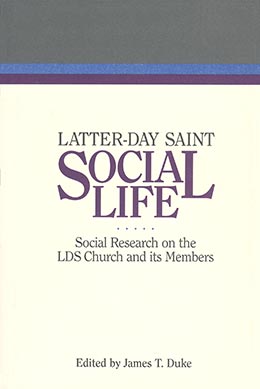Religion and Adolescent Social Competence
Darwin L. Thomas and Craig Carver
Darwin L. Thomas and Craig Carver, “Religion and Adolescent Social Competence,” in Latter-day Saint Social Life: Social Research on the LDS Church and its Members (Provo, UT: Religious Studies Center, Brigham Young University, 1998), 373–400.
Darwin L. Thomas is professor of sociology at Brigham Young University. Craig Carver teaches seminary at American Fork Junior High School in American Fork, Utah. This article was originally published in Developing Social Competence in Adolescence, edited by Thomas P. Gullotta, Gerald R. Adams, and Raymond Montemayor. Newbury Park: Sage, pp. 195–219. Copyright ©1990 by Sage Publications, Inc.; reprinted with permission.
Abstract
A review of the research on religious influence on adolescent social competence shows that religious commitment is consistently related to increased competence. Research that is most often done relates religiosity to measures of low social competence such as substance abuse, deviant behavior, or self-derogation and reveals an inverse pattern of relationships. These findings are interpreted as supporting a Durkheimian view wherein religion helps people “live better” in their social order. Future research could profitably focus more on the social support function of the religious institution rather than concentrate on the social control function emphasized in past research. Religious commitment not only helps adolescents develop interpersonal skills and a set of positive values about life in the here and now, but it also assists adolescents in making important plans for the future. This ability to plan for the future is an important dimension of adolescent social competence preparatory for moving into the young adult years.
In this chapter we use the concept “social competence” in a general sense to refer to the degree that an adolescent develops the relevant attitudinal and behavioral repertoire that a given social order sees as good and desirable. Our general conceptualization sees social competence as consisting of a socially valued dimension defined by such characteristics as self-esteem, academic achievement, intellectual development, creativity, moral behavior, and/
The theoretical formulation informing our discussion is a general social psychological one that assumes the human organism is equipped at birth to seek out those responsive elements in the environment that allow for maximal growth and development. Although this can be seen as a position that emphasizes the biological base for human behavior, it should not be misread as merely a statement similar to Maslow’s formulation that reduces ethics to biological competence. We agree with Smith (1974), who argues that any position that requires biology to carry ethics is deficient. We assume that the human organism is biologically equipped for prosocial behavior, but we see the environment as being at least partly responsible for the trajectory that growth and development take over the ensuing years of that organism’s life. We also see the human being developing capacities so that at some point he or she becomes partly responsible for the trajectory that development takes (see Rollins and Thomas 1979 for a more in-depth discussion of these underlying assumptions). Following Etzioni (1989), the “judging self,” not reducible solely to hedonistic motivation, mediates between social influence and the resultant socially competent or incompetent behavior and/
A useful way of talking about environmental influences on social competence is to conceptualize any social order as varying on two fundamental axes; namely, the amount of emotional support and encouragement for individual growth and development and the amount of control or restriction placed upon individual development. This formulation has proved useful for analysis of the family’s effect upon adolescent growth and development (see Barber and Thomas 1986b; Rollins and Thomas 1979 for exemplary discussions). D’Antonio (1983), Aldous and D’Antonio (1983), and Thomas and Cornwall (1990) have discussed the utility of using support and control dimensions in understanding some aspects of the religion and family interface. Our use of the concepts of support and control as important dimensions of the religious sphere allows us to call attention to the two important functions that religion performs: namely, being both a supportive and motivating force and a controlling and guiding force (Collins 1982; Pescosolido and Georgianna 1989; Thomas and Cornwall 1990; Wellman 1983). In this chapter we use the support and control constructs in the religious sphere to help assess religious influence upon social competence. We review the extant empirical research that links religiosity to various dimensions of social competence. We then attempt a theoretical discussion of some of the patterns emerging in the data on the religious environment’s influence that help identify lines of the profitable future research on social competence.
The Place of Religion in Contemporary Adolescent Research
There is considerable agreement that since 1950 the social sciences have experienced an unusual resurgence of interest in the study of religion (Thomas 1988; Thomas and Cornwall 1990; Thomas and Henry 1985). This new interest not only has generated more empirical studies of religion but has also manifested itself in an increasing number of social scientists organizing within various disciplines (sociology, psychology, economics, and so on) to encourage more research and theorizing about religion in contemporary society (D’Antonio and Aldous 1983; Thomas and Henry 1985; Thomas and Sommerfeldt 1984). This in and of itself is an intriguing set of occurrences in the social sciences, given that from the early 1900s up to 1950 the study of religion, at least in the United States, had dwindled significantly—to the point that the psychology of religion, for example, was pronounced dead (Beit-Hallahmi 1974). In terms of the effect this new emphasis has had on this chapter, we should ask: Has the study of adolescence mirrored this increased interest in religion?
In attempting to answer this question, we consulted sixty textbooks published from 1960 to 1988 in the area of child and adolescent development and analyzed them in an attempt to see increasing or decreasing patterns of discussions of religion. We found no evidence of increasing interest in the study of religion as it relates to human growth and development, specifically in the substantive area of adolescence: forty-four of the texts made no mention at all of religion, nine of the texts briefly mentioned religion, and only five had what could be classified as an extended discussion within a chapter. Only two of the sixty books had a chapter that included the topic of religion in the title. Neither the word religion nor any of its derivatives were found in any of forty-six chapters in the fourth edition of the four-volume Mussen Handbook of Child Psychology (1983). In the index for the 3,819 pages, the two relevant entries are “religious conversion” and “religion and morality.” Thus our conclusion is that the area of adolescence in the social sciences up to the present time has not reflected an increased interest in religion as have some other areas of study. Perhaps the presence of this chapter in a book on adolescent development as it relates to social competence may be indicative of the beginning of interest in religion.
Religion and Social Incompetence
Our review of the extant empirical research leads us to conclude that when empirical studies of religion and social competence have been carried out, they have more traditionally focused on low social competence; or, put another way, they have focused on those devalued adolescent attitudinal and behavioral variables. This is largely due to the fact that the topic of substance abuse concerning alcohol, drugs, and so on has been the major area in which religious influence has been analyzed.
Table 12.1 presents a summary of our review of that literature. Because the amount of published material in any of the four substantive areas is voluminous, we have selected only five studies with representative findings in each area. As can be seen from the table, it is clear that a consistent relationship emerges in the literature: The higher the involvement in the religious sphere, the lower the frequency, intensity, or duration of these various forms of antisocial behavior. Much of the available research merely measures religion as affiliation within a particular denomination. The denominations are seen as ones that have greater normative pressures against the use of particular substances or behavior. We then conclude that the denominations are influential in controlling and reducing this particular behavior.

The most convincing research, however, shows that, within any one denomination, the level of religious commitment that members of that denomination experience in their attendance patterns or belief patterns likewise predicts differential levels of acceptance of deviant behavior. Thus all of this research clearly shows that it is not just the denominational emphasis upon particular beliefs (Cornwall and Thomas 1986) but the degree to which the adolescent has internalized those values related to the respective behavior.
The dominant theoretical orientation underlying virtually all of the extant research that sees religious involvement as inversely related to antisocial behavior is best described as social control theory. Religion is seen as an important institution of social control that discourages antisocial behavior by highlighting negative consequences not only in the here and now but likewise in the “world to come.” Religion is seen as appealing to the adolescent who needs to have a social world in which divine providence will eventually be played out as rewards and punishments are meted out in a this-and-other-world scheme of things. The chief motivation for not engaging in antisocial behavior is the desire to avoid the hellfire consequences of one’s behavior. The controlling and guiding influence of religious authority is emphasized. One searches almost in vain for analyses of the possible role of religion as socially supportive, motivational, or facilitative.
Religion and Social Competence
Table 12.2 presents a review of extant literature that links religious involvement and commitment to various dimensions of social competence. First, when looking at the table, note that there are considerably fewer studies that link positive developmental aspects to religion. This is an important finding.
The most obvious pattern from the data is the consistency of results across these studies showing that involvement in and commitment to religion is positively correlated with social competence. This finding addresses a current controversy in the field: Is religion related to positive or negative outcomes (Batson and Ventis 1982; Bergin 1983; Judd 1985; Thomas 1988)? When the patterns of findings in tables 12.1 and 12.2 are taken together, they show that, for the most part, religious involvement and commitment is consistently related to increasing the abilities and skills required for adequate functioning in society and to decreasing the tendency to develop attitudes and participate in activities that are devalued in society.
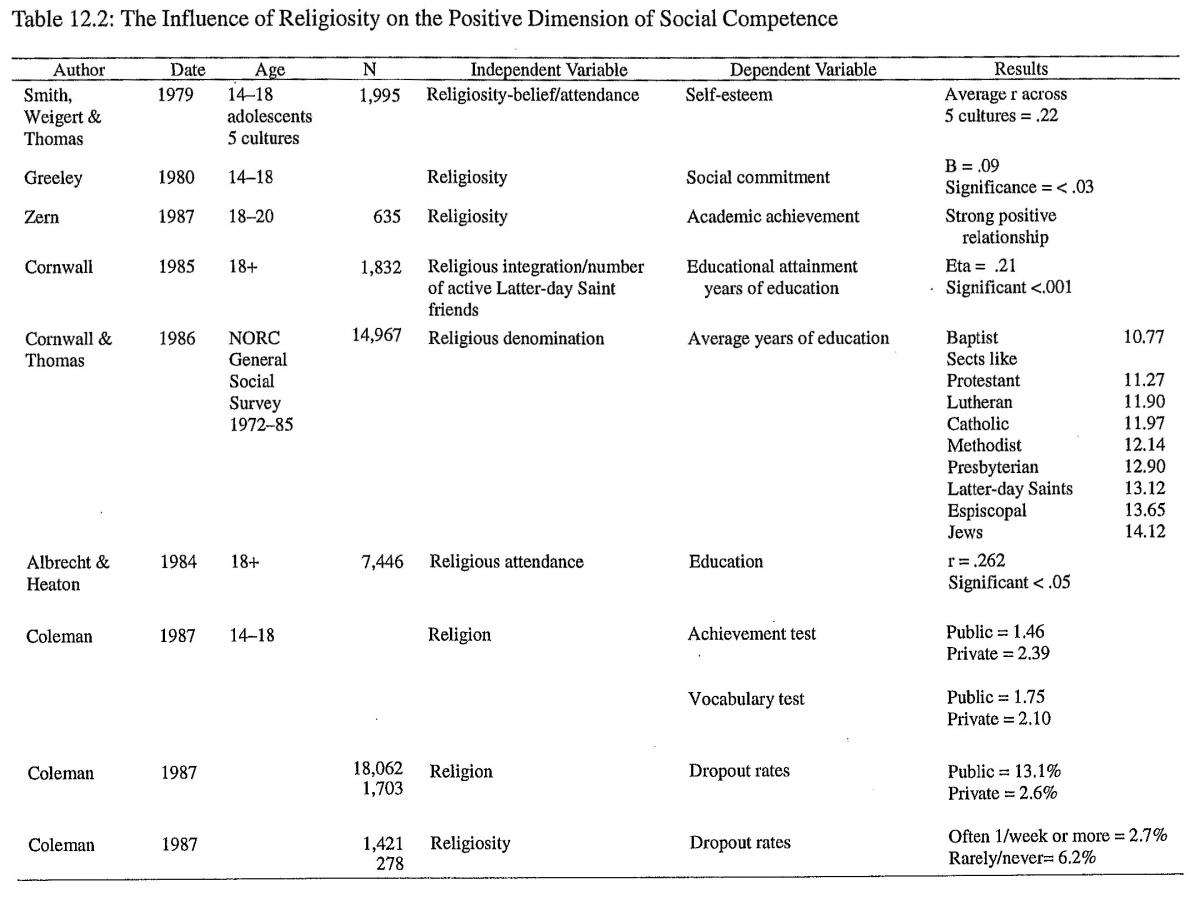
There are not enough studies in any one substantive area to make conclusive judgments about whether religion seems to be more effective at producing some positive outcomes rather than others. With fewer than five studies in any one substantive area, a summary attempt such as this at best can present only tenuous suggestions. From the patterns that we think are suggested in the table, we tentatively conclude that religion has a greater influence on an individual’s ability to function in another social setting such as the educational setting rather than in developing some ability that cuts across all social settings. Regarding religion’s relationship to academic achievement, for example, it seems that, in this arena of interaction, what is learned in a religious setting is more directly transferable to how one operates and performs in an educational setting.
The data do not allow us to draw firm conclusions as to why this would be so. But we agree with basic Durkheimian formulations that integration into social orders is the critical element in preparing people to “live better.” This theoretical explanation focuses on important social processes rather than pointing toward dimensions of personality or individual attitudes (see Cornwall 1987; Pescosolido and Georgiana 1989, for a similar formulation). We assume that as the individual becomes integrated into the religious social sphere and accepts the set of values surrounding those social relationships, he or she becomes more sensitive to interpersonal expectations from significant others, finds it easier to develop goals, and more readily identifies personal abilities needed to achieve those goals. We see such interpersonal skills as being transferable to an educational setting, which assists the religious person in becoming a better student.
Further research will be needed to determine whether this interpretation holds, but we think the research reported by Zern (1987) is supportive of this line of reasoning. That research did not find religiosity to be predictive of grade point average (GPA) specifically but did find religiosity to be positively and strongly related to academic achievement based on ability, which combined GPA with SAT scores. When measures of ability (SAT scores) are included in the analysis along with academic achievement (grades), Zern concludes that religiously involved and committed adolescents are significantly better able to more consistently reach their potential.
The last finding from our comparison of tables 12.1 and 12.2 leads us to what we think is the most important finding in our attempt to analyze extant research in which religion is linked to measures of social competence. The conclusion is a simple one, but the implications are far reaching. In essence, we think that because religion is linked to positive dimensions of social competence as well as negative dimensions, there is a need to reevaluate theoretically what religious involvement and commitment mean. The research literature used to further inform our theoretical speculations along these lines does not come specifically from research linking religion with adolescent growth and development, but we think the findings from that research can be used to interpret and give direction to future research in this area.
Religion and Adolescent Plans for the Future
The most common pattern clearly shown in religion and adolescence research is to conceptualize religion as an effective control mechanism within society. Thus adolescents are seen as opting not to engage in antisocial behavior (delinquency and so on) because of the threat the religious institution holds over the thinking, feeling, and acting adolescent. A brief look at the deviance literature that studies religion will show this common interpretation of why religion is an effective social control mechanism. The various articles that focus on hellfire and other aspects of religion emphasize this point. As observers have noted, theorists are late in rethinking the controlling and supportive mechanisms of religion (Thomas and Cornwall 1990).
Another area that has traditionally used a similar kind of explanation for one of the most recurring findings in the social sciences is the study of the relationship of religious involvement and commitment to marital satisfaction. In the marital satisfaction literature, one of the most consistent and oft-reported findings since the 1930s is the positive correlation between religious involvement and commitment and marital satisfaction. For years this finding tended to be ignored; that is, it was often just reported in the literature without theoretical discussion or attempts to understand it. Eventually attempts were made and a common interpretation was that the relationship between religious involvement and marital satisfaction was probably a spurious relationship and reflected the fact that religious people tended to be more tuned in to the normative expectations of appropriate behavior in a particular social setting. Thus because of their greater sensitivity to socially desirable answers, religious respondents would merely indicate that “yes, they were committed to religion and yes, things in their marriage were going along pretty well.” This interpretation remained unchallenged in the literature until the late 1970s and early 1980s when a number of researchers began to question it.
Filsinger and Wilson (1984; Wilson and Filsinger 1986), who looked seriously at the relationship and included measures of social desirability, showed that social desirability did not attenuate the relationship. In fact, controlling for social desirability increases the strength of the relationship between marital satisfaction and religious involvement. They suggest that social scientists are late in questioning what it is that religion contributes to the marital relationship other than simple mechanisms of social control (i.e., by stopping unhappy couples from divorcing). Other people (Schumm, Bollman, and Jurich 1982) have also presented evidence that religious involvement and commitment may add some very important, positive elements to marital and family relationships.
The same rationale helps us understand the data on adolescent social competence and underscores the facilitative influence of religious involvement and commitment on the adolescent’s social growth and development. Although we were unable to find a lot of research that addressed the question of how religion facilitates adolescent social competence, there is one line of recent research that allows more in-depth discussion. It is apparent from a number of kinds of research that socially competent adolescents are characterized by the ability to plan for the future. The socially competent adolescent does not live only in the present dimensions of life but anticipates coming stages of life and seems to make active plans for the future (Blinn 1988; Dryfoos 1988). Dryfoos presents a persuasive argument that adolescents who attain status in our contemporary society are clearly the ones who (for whatever reason) are able to make meaningful plans for the future (education, occupation, and so on). Blinn’s research (1988) clearly shows that adolescents with low social competence, specifically those who find themselves in an early teen pregnancy, have very unrealistic and distorted views about what their lives will look like in the future. Not only do they lack specific plans for the future, the list of things they think life is going to provide to them is very unrealistic. Her research shows that, although some aspects of the adolescent’s world change during the course of the pregnancy, their unrealistic views of future life for the most part remain unchanged. Additional research will have to determine when the pregnant adolescent begins to reorder her views of the future to more closely correspond with the hard reality that the future will probably bring.
Even more directly related research shows the impact of belief and involvement in the religious sphere on an adolescent’s plan for the future (Ensign 1984). Figs. 12.1, 12.2, and 12.3 show LISREL models of basic findings from a sample of U.S. Mormon male adolescents between the ages of twelve and eighteen. This research shows that values and plans for the future (to get a college education, to get a good job, to go on a mission for the Mormon Church, to be married in a church ceremony, and so on) are significantly influenced by the level of personal religious commitment that the adolescent experiences in his or her life. Plans and values are also influenced by involvement in the religious, public sphere of church attendance, and so on, but note that the influence of the public sphere is much less strong than that of the private religious sphere.
In addition to adolescent religiosity, there are two important sources of influence on the adolescent’s future plans and values, namely, the family’s home religious observance (scripture study, prayer, and so on) and the influence of the adolescent’s adult religious advisor. Thus both family and the church are important sources of influence in the life of the young person as he or she creates his or her own public and private approaches to religion and establishes values and plans for the future.
FIGURE 12.1: Family and Religion’s Influence on Religious Goals and Values
Note: Goodness of fit index is 0.996. Root mean square residual is 0.22.
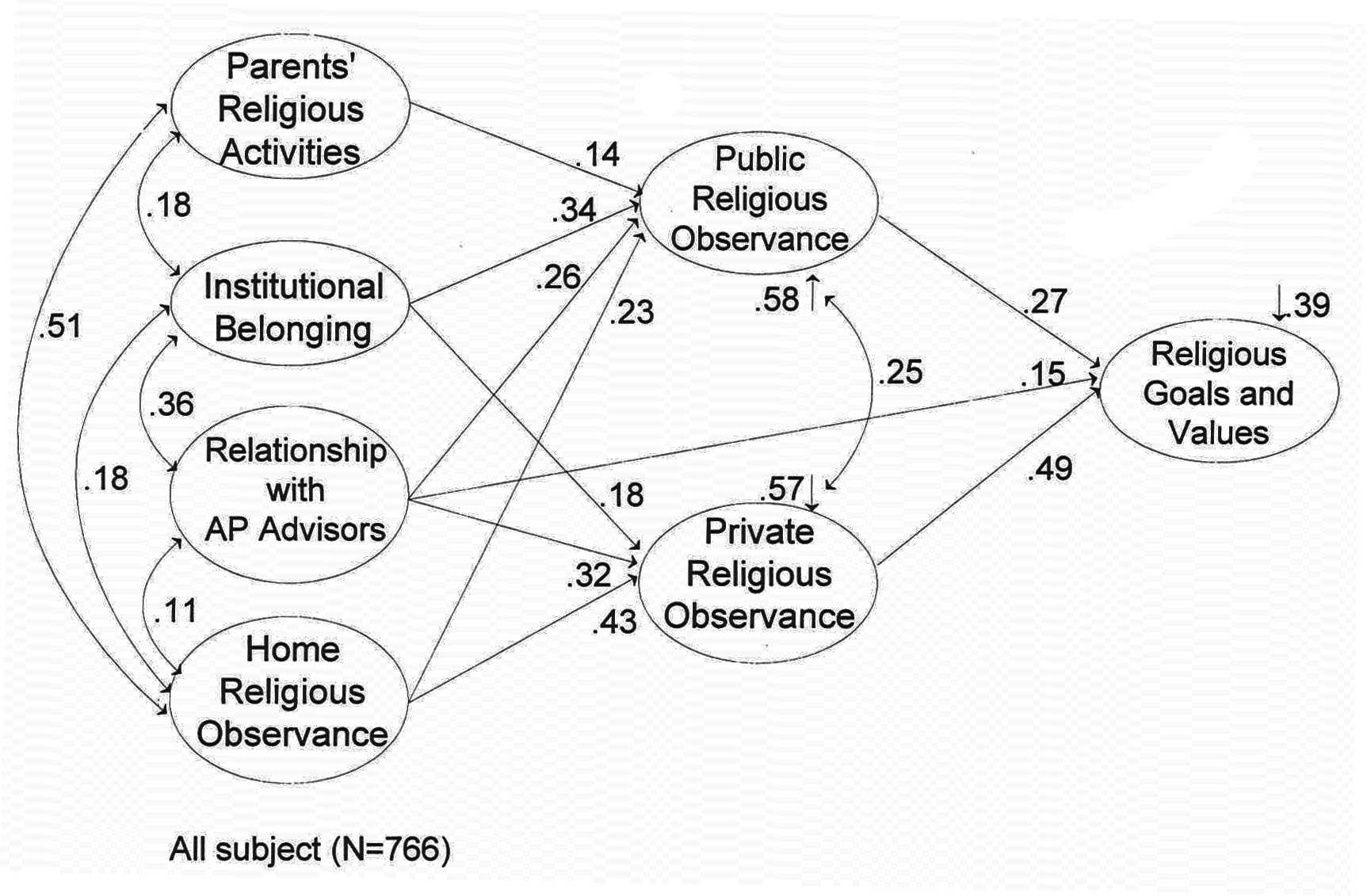
FIGURE 12.2: Family and Religion’s Influence on Religious Goals and Values
Note: Goodness of fit index is 0.989. Root mean square residual is 0.043.
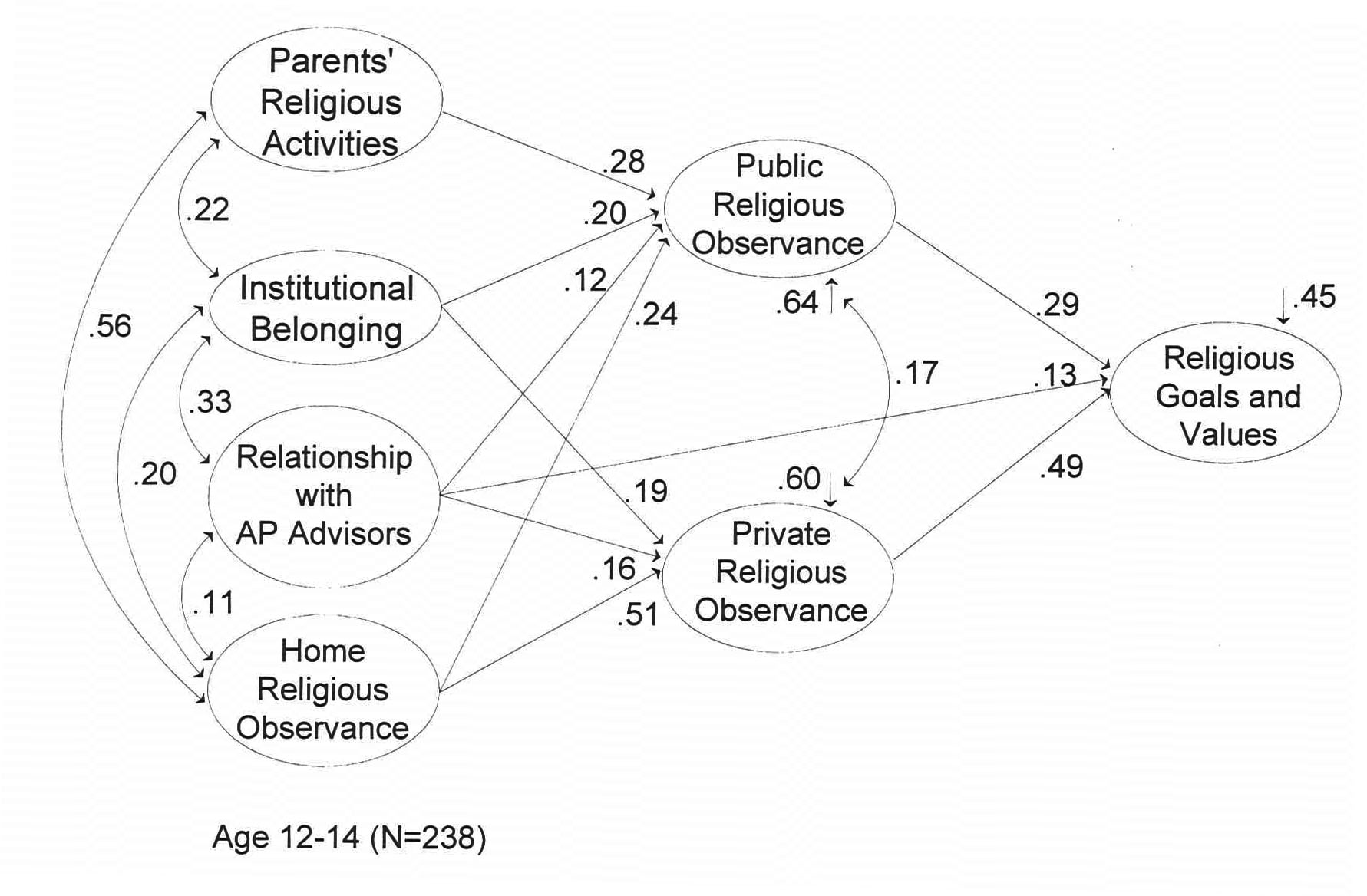
FIGURE 12.3: Family and Religion’s Influence on Religious Goals and Values
Note: Goodness of fit index is 0.990. Root mean square residual is 0.025.
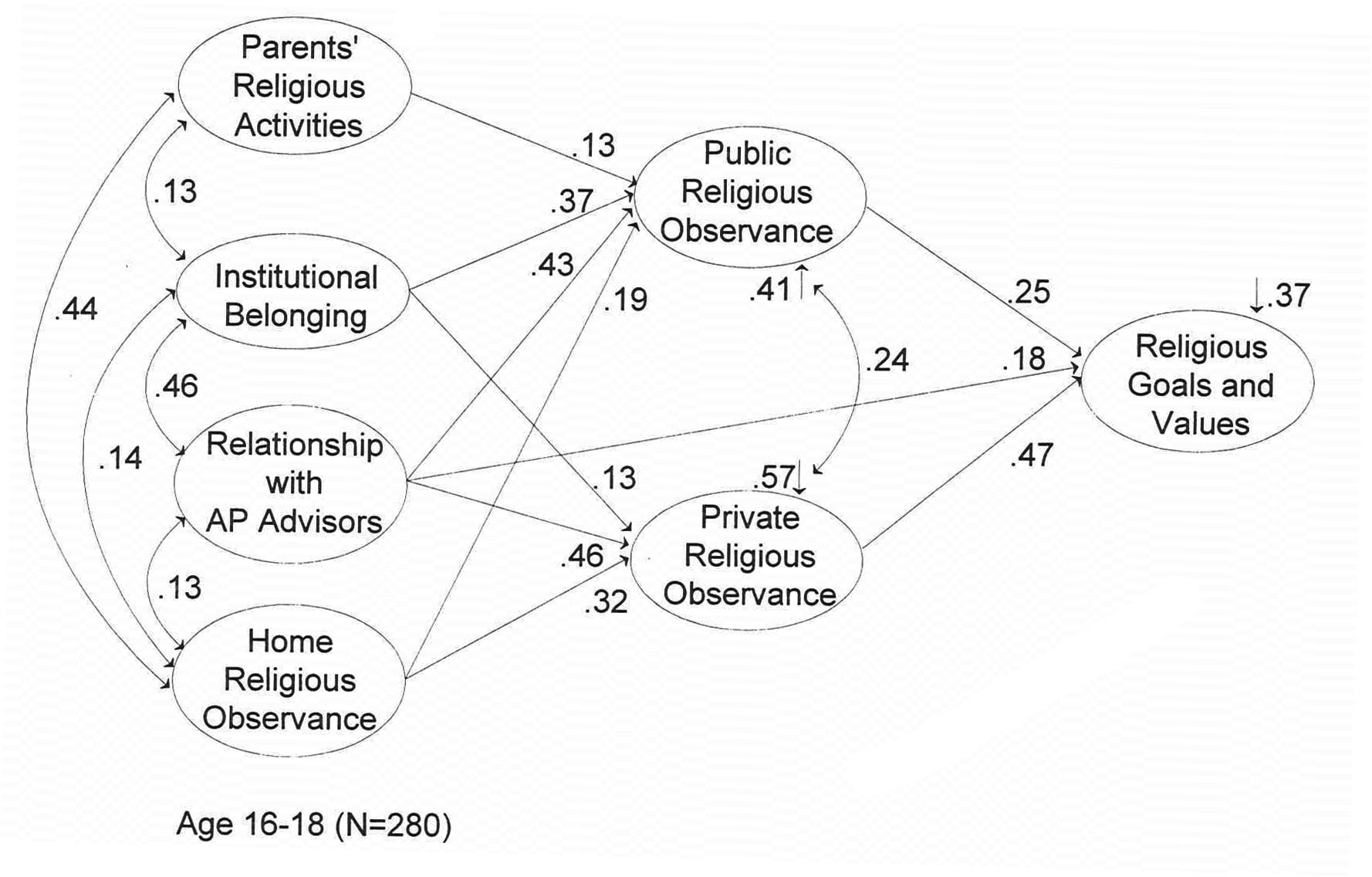
Figs. 12.2 and 12.3 present the same LISREL models, but limited to the younger adolescents (those between the ages of twelve to fourteen) and the older adolescents (between the ages of sixteen to eighteen). A comparison of those two age groups shows what changes occur in family influence and church influence during the life of the young person. Family influence is much stronger for the younger adolescent. Note that the influence of home religious observance on the private religious observance of the twelve- to fourteen-year-old adolescent is strong (.51 standardized coefficient) whereas the relationship with the advisor and institutional belonging are weak (.16 and .19 standardized coefficients). However, when those values are compared with the values for the sixteen- to eighteen-year-old adolescent, home religious observance drops to a .31, whereas the relationship with the “Aaronic Priesthood Advisor” increases to .47.
These data are consistent with the conclusion that, as adolescents move through those developmental years, the influence of the home recedes in importance and other influences become more important. In this data set the relationship that the young person establishes with the significant other representing the Church, namely, his priesthood advisor, becomes much more important. We interpret these findings to mean that the world of the adolescent is changing in focus from home to outside areas. In this case religion, symbolized through another adult figure, becomes important in establishing critical plans for the future. Instead of only showing religious involvement and commitment as social control mechanisms, we believe this research shows that religion assists and helps the adolescent create meaningful goals and internalize a set of values that lead to the enhancement of life and an increased ability to achieve those goals.
Research (Weed and Olsen 1988), with a predominantly Mormon sample of four thousand adolescents in schools throughout the state of Utah, shows the very important role of religion in combination with family as related to the peer, educational, and deviant worlds of the adolescent. Fig. 12.4 shows the standardized path coefficients between a number of variables in that study.
FIGURE 12.4: Standardized Regression Coefficients for Model of Sexual Activity
Source: Adapted from Weed and Olsen (1988).
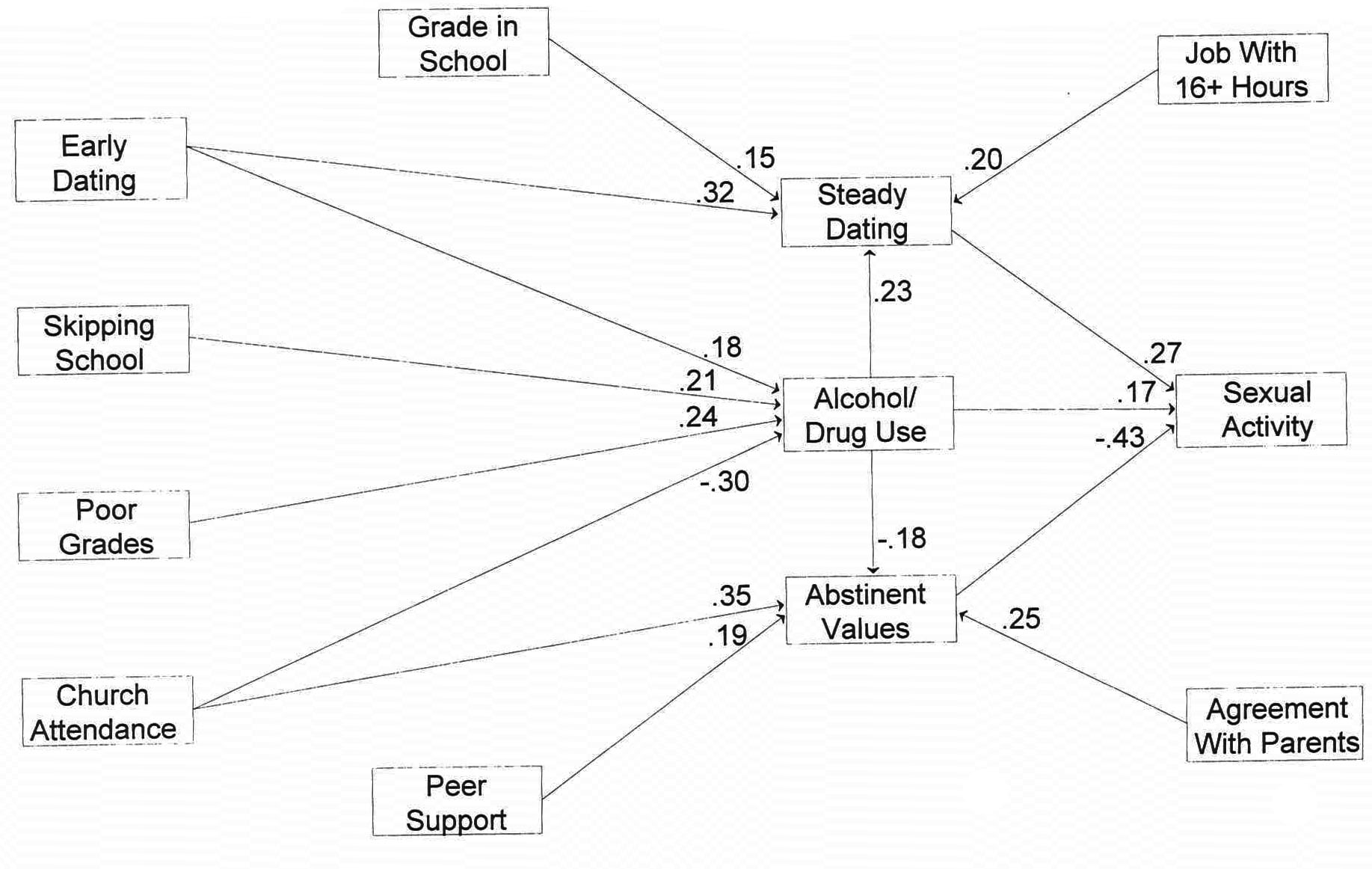
In our interpretation, the significant relationship is the very strong standardized beta coefficient between abstinent values and sexual activity. Note that, in terms of predicting adolescent sexual activity, these abstinence values are twice as good as other more commonly found dimensions of the adolescent world, namely, steady dating and alcohol and drug use. Note also that church attendance is a very important predictor of this set of adolescent abstinence values. This is further evidence for the impact of involvement in and commitment to religion as represented through church attendance. This research clearly shows that the agreement with parents on values, support one receives from peers for those values, and adolescent involvement in the religious sphere are dominant and important predictors of sexual attitudes and values, which in turn affect actual sexual activity.
We think that by combining these two sets of research we can make a persuasive argument for the supportive and facilitative function that religion provides in forming a set of values around which the adolescent is then able to create a set of specific goals for the future. Having future goals provides motivation that serves as a very significant buffer against some of those influences in the adolescent world which lead to antisocial behavior. Religion seems to facilitate the establishment of meaningful values along with realistic goals for the future, thus enhancing the adolescent’s ability to reach his or her potential.
Future Research
Given the above analysis, what are we to make of our assessment of the impact of religious involvement and commitment upon adolescent social competence? We suspect that the best research will conceptualize the influence of religion in terms not only of its social control ability but also of its positive life-sustaining and life-developing dimensions. Although we do not necessarily agree with Hall’s observation that “religious conversion should occur in adolescence because it is a natural, normal, and universal process” (Hall 1904, vol. 2, p. 301), we do believe that the adolescent years can be defined as an important stage in the search for a meaningful worldview.
We see the significance of this stage as having essentially two dimensions. First, the adolescent comes to internalize a set of values that emphasizes the right of institutions in society to exercise social control. This is toe restricting and guiding dimension required for normal social interaction that every society elicits from its members. We see this function as necessary, and we see religion as contributing to it. The voluminous research on adolescence and deviant behavior also points to this interpretation. We see a critical need for further research to address how this function of religion is related to the second function of offering social support and motivation.
Future research should study how religion adds to the positive dimensions of adolescent growth and development. Here we think that religion and the family are the two central institutions within which adolescents attempt to work out their own views of life, focusing on aspects of life that require a positive commitment. Most crucial in defining this aspect of the adolescent’s world is not the control and restriction dimension of the religious institution but the emotional support and encouragement that the adolescent receives through that religious institution. While the family recedes in importance as the institution begins to provide emotional support for the adolescent, we need to know who the religious significant others have become. The research reported in figs. 12.1 through 12.3 suggests the importance of these significant adults who represent the religious organization. We need to know how useful they are in assisting the adolescent in working through his or her plans for the future and internalizing social values.
We suspect that future research will show these adults in the religious sphere to be effective not because they emphasize the control and restriction dimension of religion but because they are people who provide significant social support and emotional sustenance in their relationships with adolescents. Here we think the religious functionary becomes very important in assisting the adolescent to come to know him- or herself and the social world so that plans for the future make sense, life in the present is basically a positive and rewarding experience, and the best life is lived with an eye to the future. In this sense we think that the universal nature of conversion that Hall was talking about is applicable in this broader social psychological arena within which we think these processes occur.
To the degree that control and restrictions are balanced with emotional support and encouragement, we think that both religion and family can be combined to effectively assist the adolescent to achieve maximal socially competent skills, attitudes, and behaviors.
Finally, let us represent through fig. 12.5 the basic dimensions of the adolescent’s social world that have been studied and those which we think ought to be studied longitudinally to better appreciate the significance of social competence in the adolescent years. First, we assume that the religious, family, educational, and peer worlds are the most important spheres in the life of the adolescent. Second, we assume that social competence in the form of interpersonal skills, an interrelated set of values underscoring the positive dimensions of life, and a set of plans for the future are the critical outcomes in these years of growing up.
FIGURE 12.5: Model of Institutional, Relational, and Individual Variables Effects on Young Adult Well-Being
Note: The arrows represent relationships that we judge to have been supported by empirical research.
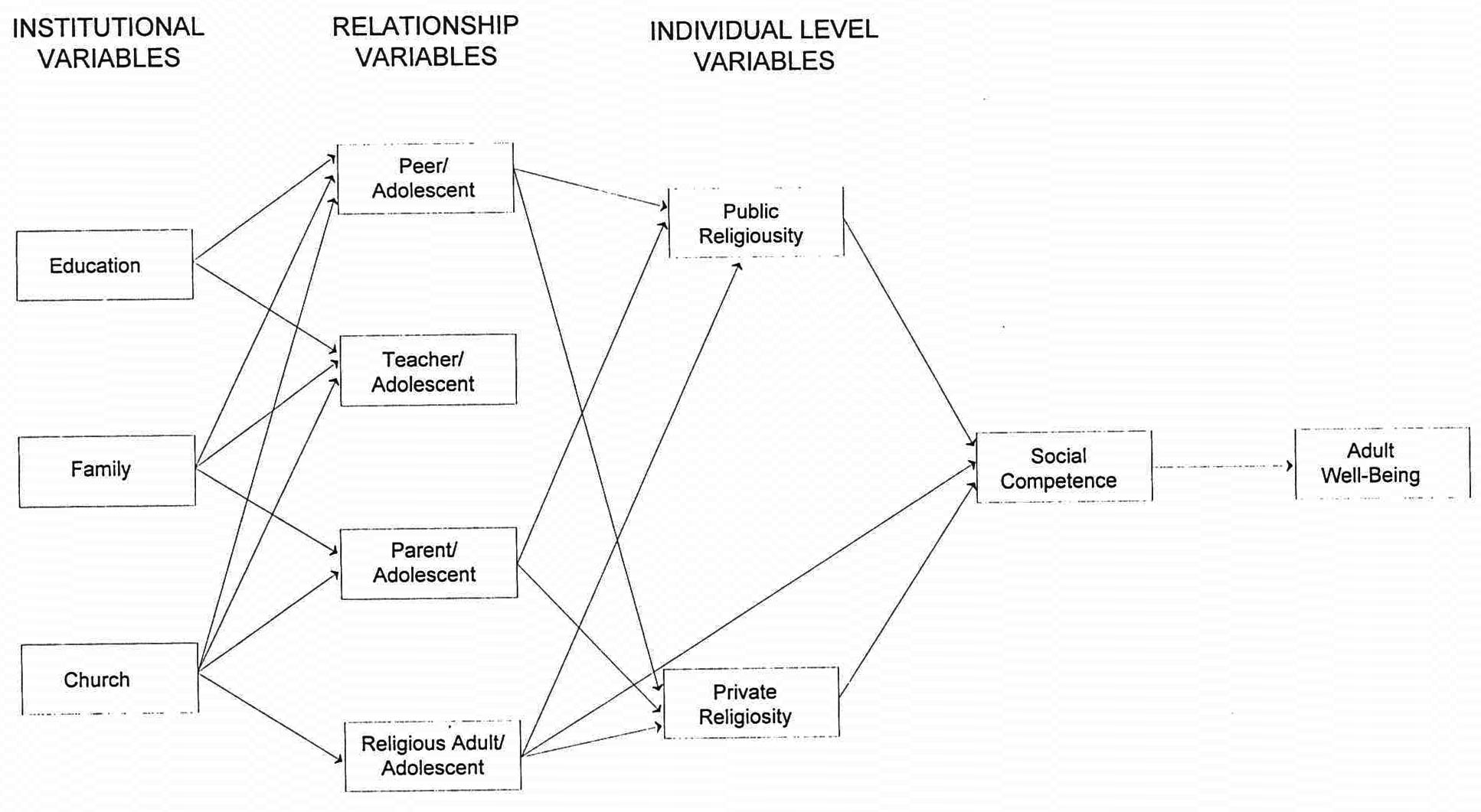
The importance of any of these institutional spheres (religion, family, education, peer) cannot be determined by studying them in isolation. The best research will be that which studies the adolescent’s simultaneous involvement in and commitment to these multiple social institutions. Fig. 12.5 represents some lines of influence that we think previous research and theory have supported. However, many relationships among the institutional, relational, and individual variables have not been adequately studied.
Longitudinal research on adolescent social competence in which the influence of multiple social institutions is analyzed will help social psychologists better understand the relationship of social competence to the normative order. For example, in the area of sexual activity, research shows that religiosity is negatively related to contraceptive use among adolescents. This highlights the normative order underlying the negative and positive dimensions of social competence. Currently, American society is ambivalent about whether it should define contraceptive use as prosocial or antisocial behavior (for exemplary discussions see Dryfoos 1988; Moore 1988; Olsen 1988; Weed and Olsen 1988). The part of the social order that believes in abstinence for adolescents and opposes easy access to contraceptives sees the use of contraceptives as undesirable and, therefore, incompetent behavior. Another part of society that sees sexual activity as normal adolescent behavior and wants to encourage contraceptive use to prevent pregnancy will label contraceptive behavior as socially competent behavior.
Longitudinal research should be able to assess the relative influence on adolescents of the efforts of various social institutions. The attitudes and behavior developed in adolescence can then be linked to positive and negative outcomes in the young adult years to better see how social competence is developed and defined during times of rapid social change. When the social order (or parts of it) changes and defines attitudes/
We need to know to what extent religion, family, education, and peer worlds have independent effects over and above the effect that social competence has on young adult well-being. Research of this type will allow us not only to better understand social competence in adolescence but also to begin to see how experiences in the social psychological realm in adolescent years are or are not related to the realities of the young adult world. To the degree that discussions of this type will lead to more carefully conceptualized and conducted longitudinal research, social psychology in general and adolescents in particular will benefit from that combined effort.
References
Albrecht, Stan L., Bruce A. Chadwick, and David S. Alcorn. 1977. “Religiosity and Deviance: Application of an Attitude-Behavior Contingent Consistency Model.” Journal for the Scientific Study of Religion 16:263–74.
Albrecht, Stan L. and Tim B. Heaton. 1984. “Secularization, Higher Education, and Religiosity.” Review of Religious Research 26:43–58. Also in this volume.
Aldous, Joan and William V. D’Antonio. 1983. “Introduction: Families and Religions Beset by Friends and Foes.” Pp. 9–16 in Families and Religions: Conflict and Change in Modern Society, edited by W. V. D’Antonio and J. Aldous. Beverly Hills: Sage Publications.
Bahr, Stephen J. and Anastasios C. Marcos. 1986. “Adolescent Drug Use.” In Utah Demographic Perspective, edited by T. K. Martin et al. Salt Lake City: Signature.
Barber, B. K. and Darwin L. Thomas. 1986a. “Dimensions of Adolescent Self-Esteem and Religious Self-Evaluations.” Family Perspective 20:137–50.
———. 1986b. “Dimensions of Fathers’ and Mothers’ Supportive Behavior: The Case for Physical Affection.” Journal of Marriage and the Family 48:783–94.
Batson, C. Daniel and W. Larry Ventis. 1982. The Religious Experience: A Social-Psychological Perspective. New York: Oxford University Press.
Beit-Hallahmi, Benjamin. 1974. “Psychology of Religion in 1880–1930: The Rise and Fall of a Psychological Movement.” Journal of the History of the Behavioral Sciences 10:84–94.
Bergin, Allen E. 1983. “Religiosity and Mental Health: A Critical Reevaluation and Meta-Analysis.” Professional Psychology: Research and Practice 14:170–84.
Blinn, Lynn M. 1988. “Stability and Change in Pregnant Adolescents’ Perceptions of Their Future Marriage and Family Life.” Family Perspective 22:255–68.
Breault, Kevin D. 1986. “Suicide in America: A Test of Durkheim’s Theory of Religious and Family Integration, 1933–1980.” American Sociological Society 92:628–56.
Burkett, Steven R. 1987. “Religion, Parental Influence, and Adolescent Alcohol and Marijuana Use.” Journal of Drug Issues 7:263–73.
Burkett, Steven R. and Mervin White. 1975. “Hellfire and Delinquency: Another Look.” Journal for the Scientific Study of Religion 13:455–62.
Coleman, James Samuel, Thomas Hoffer, and Sally Kilgore. 1982. High School Achievement: Public, Catholic, and Private Schools Compared. New York: Basic Books.
Collins, Randall. 1982. Sociological Insight. New York: Oxford University Press.
Cornwall, Marie. 1985. “Personal Communities: The Social and Normative Bases of Religion.” University of Minnesota, Minneapolis. Unpublished manuscript.
———. 1987. ‘The Social Bases of Religion: A Study of the Factors Influencing Religious Belief and Commitment.” Review of Religious Research 29:44–56.
Cornwall, Marie and Darwin L. Thomas. 1986. “Religion and Education in the Secularization Thesis: A Look at the Mormons.” Paper presented at the Sunstone Symposium, Salt Lake City, May.
D’Antonio, William V. 1983. “Family Life, Religion, and Societal Values and Structures.” Pp. 81–108 in Families and Religions: Conflict and Change in Modern Society, edited by W. V. D’Antonio and J. Aldous. Beverly Hills: Sage.
D’Antonio, William V. and J. Aldous. 1983. Families and Religions: Conflict and Change in Modern Society. Beverly Hills: Sage.
Dryfoos, Joy G. 1988. “Using Existing Research to Develop a Comprehensive Pregnancy Prevention Program.” Family Perspective 22:211–23.
Editors of the Ensign. 1984. “Aaronic Priesthood Age Boys’ Plans for the Future.” Ensign 14:52–54.
Elifson, Kirk W., David M. Petersen, and C. Kirk Hadaway. 1983. “Religiosity and Delinquency: A Contextual Analysis.” Criminology 21:505–27.
Etzioni, Amitai. 1989. “The ‘Me First’ Model in the Social Sciences is Too Narrow.” Chronicle of Higher Education (1 Feb.): A44.
Filsinger, Erik E. and Margaret R. Wilson. 1984. “Religiosity, Socioeconomic Rewards, and Family Development: Predictors of Marital Adjustment.” Journal of Marriage and the Family 46:663–70.
Forste, Renata Tonks and Tim B. Heaton. 1988. “Initiation of Sexual Activity among Female Adolescents.” Youth and Society 19:250–68.
Hadaway, C. Kirk, Kirk W. Elifson, and D. M. Petersen. 1984. “Religious Involvement and Drug Use among Urban Adolescents.” Journal for the Scientific Study of Religion 23:109–28.
Hall, G. Stanley. 1904. Adolescence: Its Psychology and Its Relations to Physiology, Anthropology, Sociology, Sex, Crime, Religion, and Education. 2 vols. New York: Appleton.
Jensen, Gary F. and Maynard L. Erickson. 1979. “The Religious Factor and Delinquency: Another Look at the Hellfire Hypothesis.” Pp. 157–77 in The Religious Dimension: New Directions in Quantitative Research, edited by Robert Wuthnow. New York: Academic Press.
Judd, Daniel K. 1985. “Religiosity and Mental Health: A Literature Review 1928–1985.” Brigham Young University, Provo, UT Unpublished manuscript.
Lester, David. 1987. “Religiosity and Personal Violence: A Regional Analysis of Suicide and Homicide Rates.” Journal of Social Psychology 127:685–86.
McLuckie, Benjamin F, Margaret A. Zahn, and Robert A. Wilson. 1975. “Religious Correlates of Teenage Drug Use.” Journal of Drug Issues 5:129–39.
Martin, William T. 1984. “Religiosity and United States Suicide Rates, 1972–1978.” Journal of Clinical Psychology 40:1167–69.
Moore, Kristin A. 1988. “Teenage Childbearing: Unresolved Issues in the Research/
Mussen, Paul H., ed. 1983. Handbook of Child Psychology. New York: John Wiley and Sons.
Olsen, Joseph A. 1988. “The Teenage Pregnancy Problem: Some Alternate Approaches to Policy and Research.” Family Perspective 22:171–87.
Peek, Charles W., Even W. Curry, and Paul Chalfant. 1985. “Religiosity and Delinquency over Time.” Social Science Quarterly 66:120–31.
Pescosolido, Bernice A. and Sharon Georgianna. 1989. “Durkheim, Suicide, and Religion: Toward a Network Theory of Suicide.” American Sociological Review 54:33–48.
Rhodes, Albert Lewis and Albert J. Reiss Jr. 1970. “The ‘Religious Factor’ and Delinquent Behavior.” Journal of Research in Crime and Delinquency 7:83–98.
Rohrbaugh, John and Richard Jessor. 1975. “Religiosity in Youth: A Personal Control against Deviant Behavior.” Journal of Personality 43:136–55.
Rollins, Boyd C. and Darwin L. Thomas. 1979. “Parental Support, Power and Control Techniques in the Socialization of Children.” Pp. 317–64 in Contemporary Theories about the Family, edited by W. Burr, et al. New York: Free Press.
Ruppel, H. J. Jr. 1970. “Religiosity and Premarital Sexual Permissiveness: A Response to the Reiss-Heltsley and Broderick Debate.” Journal of Marriage and the Family 47:647–55.
Schumm, Walter R., Stephan R. Bollman, and Anthony P. Jurich. 1982. “The ‘Marital Conventionalization’ Argument: Implications for the Study of Religiosity and Marital Satisfaction.” Journal of Psychology and Theology 10:236–41.
Smith, C. B., Andrew J. Weigert, and Darwin L. Thomas. 1979. “Self-Esteem and Religiosity: An Analysis of Catholic Adolescents from Five Cultures.” Journal for the Scientific Study of Religion 18:51–60.
Smith, M. Brewster. 1974. Humanizing Social Psychology. San Francisco: Jossey-Bass.
Sorensen, A. A. and Henry S. G. Cutter. 1982. “Mystical Experience, Drinking Behavior and the Reasons for Drinking.” Journal of Studies on Alcohol 43:588–92.
Stack, Steven. 1985. “The Effect of Domestic/
Studer, Marlena and Arland Thornton. 1987. “Adolescent Religiosity and Contraceptive Usage.” Journal of Marriage and the Family 49:117–28.
Thomas, Darwin L., ed. 1988. The Religion and Family Connection: Social Science Perspectives. Provo, UT: Religious Studies Center, Brigham Young University.
Thomas, Darwin L. and Marie Cornwall. 1990. “Religion and Family in the Eighties: Discovery and Development.” Journal of Marriage and the Family 52:983–92.
Thomas, Darwin L. and Gwendolyn C. Henry. 1985. “The Religion and Family Connection: Increasing Dialogue in the Social Sciences.” Journal of Marriage and the Family 47:369–79.
Thomas, Darwin L. and Vern Sommerfeldt. 1984. “Religion, Family, and the Social Sciences: A Time for Dialogue.” Family Perspective 18:117–25.
Weed, Stan E. and Joseph Olsen. 1988. “Policy and Program Considerations for Teenage Pregnancy Prevention: A Summary for Policy Makers.” Family Perspective 22:235–52.
Wellman, Barry. 1983. “Network Analysis: Some Basic Principles.” Pp. 155–200 in Sociological Theory, edited by R. Collins. San Francisco: Jossey-Bass.
Werebe, Maria Jose-Garcia with Max Reinert. 1983. “Attitudes of French Adolescents Toward Sexuality.” Journal of Adolescence 6:145–59.
Wilson, Margaret R. and Erik E. Filsinger. 1986. “Religiosity and Marital Adjustment: Multidimensional Interrelationships.” Journal of Marriage and the Family 48:147–51.
Wolfe, Raymond N., Leisa K. Welch, Richard D. Lennox, and B. L. Cutler. 1985. “Concern for Appropriateness as a Moderator Variable in the Statistical Explanation of Self-Reported Use of Alcohol and Marijuana.” Journal of Personality 53:1–16.
Zern, David S. 1987. “The Relationship of Religious Involvement to a Variety of Indicators of Cognitive Ability and Achievement in College Students.” Adolescence 22:883–95.
